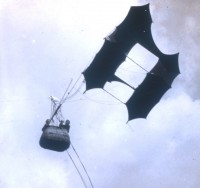Kite History

Common knowledge assumes China as the birthplace of kites. Certainly, the Chinese cultivated silk and bamboo as many as three thousand years ago, isn’t it likely that they put the two materials together and created kites? Another very logical origin theory is that the ocean-going people of Polynesia invented kites. These people had the materials, the knowledge of wind, and even perhaps, the motivation to invent the kite: kite fishing. Regardless of where kites first appeared, they followed trade routes and were common throughout Asia about 1000 years ago. In almost all Asian countries, there is a kite tradition that has evolved because of local environment, access to materials, and cultural relevance.
The first kites in Europe were probably pennon-style kites but the early history is vague. We know lozenge or pear shaped kites were a common toy by the 1600s and they appear in American history with the famous Ben Franklin electrical experiment of 1752. Kite technology – and a reason for it – occurred in the 1890s, when Lawrence Hargrave of Australia invented the box kite and William Eddy invented the tailless Malay. These allowed serious study of the atmosphere with kites and led to experiments in kite man-lifting and gliding. Kite and glider experiments led the Wright Brothers to the first powered, heavier-than-air airplane flight in 1903.
Twentieth Century kite technology includes the invention of the ram-air parafoil (Domina Jalbert) and the soft Rogallo wing. The parafoil became the standard for sport and military parachutes and the Rogallo wing led to the development of early hang gliders. Today, large, air inflated kites of any shape are commonplace and can be made and flown safely, including fish, birds, dragons, and humans.

